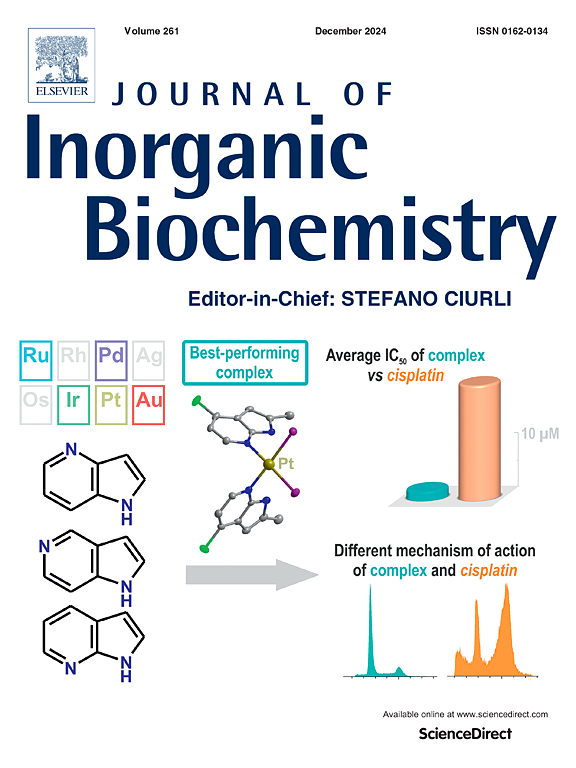三苯基锡(IV) 2-羟基-5-(苯基二氮基)苯甲酸酯的合成、结构分析及通过三氟甲基变异体调控的抗肿瘤活性的系统探索。
IF 3.8
2区 化学
Q2 BIOCHEMISTRY & MOLECULAR BIOLOGY
引用次数: 0
摘要
将 5-[(E)-2-(2-三氟甲基苯基)-1-偶氮]-2-羟基苯甲酸(H'HL3)、5-[(E)-2-(3-三氟甲基苯基)-1-偶氮]-2-羟基苯甲酸(H'HL4)和 5-[(E)-2-(4-三氟甲基苯基)-1-偶氮]-2-羟基苯甲酸(H'HL5)、用三苯基锡源 Ph3SnOH 生成了三种三苯基锡(IV)2-羟基-5-(苯基二氮基)苯甲酸盐 [Ph3Sn(HL3)] (3)、[Ph3Sn(HL4)] (4) 和 [Ph3Sn(HL5)] (5)。利用标准光谱技术和单晶 X 射线衍射 (SC-XRD) 对所得到的锡配合物进行了表征。三苯基锡配合物 3-5 显示出单体畸变四面体构型,氟取代的 2-羟基-5-(苯基偶氮)苯甲酸酯以单齿方式配位。此外,还报告了 H'HL5 的晶体结构。此外,还包括两种三苯基锡化合物 [Ph3Sn(HL1)] (1) 和 [Ph3Sn(HL2)] (2),以评估和比较它们的抗增殖特性。这里,HL1 和 HL2 分别代表 5-[(E)-2-(苯基)-1-二氮基]-2-羟基苯甲酸酯和 5-[(E)-2-(4-氟苯基)-1-二氮基]-2-羟基苯甲酸酯。评估了三苯基锡(IV)化合物 1-5 对 MCF-7(人类乳腺癌)、HeLa(人类宫颈癌)和 HEK-293(正常人类胚胎肾脏)细胞的体外抗增殖活性,并根据各种生物学测定提出了作用机制。本文章由计算机程序翻译,如有差异,请以英文原文为准。

Synthesis, structural analysis, and systematic exploration of the antitumor activities of triphenyltin(IV) 2-hydroxy-5-(phenyldiazenyl)benzoates through the modulation of trifluoromethyl variants
By reacting 5-[(E)-2-(2-trifluoromethylphenyl)-1-diazenyl]-2-hydroxybenzoic acid (H′HL3), 5-[(E)-2-(3-trifluoromethylphenyl)-1-diazenyl]-2-hydroxybenzoic acid (H′HL4), and 5-[(E)-2-(4-trifluoromethylphenyl)-1-diazenyl]-2-hydroxybenzoic acid (H′HL5), with the triphenyltin source Ph3SnOH, three triphenyltin(IV) 2-hydroxy-5-(phenyldiazenyl)benzoates [Ph3Sn(HL3)] (3), [Ph3Sn(HL4)] (4) and [Ph3Sn(HL5)] (5) were obtained. The resulting tin complexes were characterized using standard spectroscopic techniques and single-crystal X-ray diffraction (SC-XRD). Triphenyltin complexes 3–5 exhibit a monomeric distorted tetrahedral configuration, with the fluoro substituted 2-hydroxy-5-(phenyldiazenyl)benzoates coordinating in a monodentate fashion. Additionally, the crystal structure of H′HL5 is reported. Alongside these, two triphenyltin compounds [Ph3Sn(HL1)] (1) and [Ph3Sn(HL2)] (2), are included to evaluate and compare their anti-proliferative properties. Here, HL1 and HL2 represent 5-[(E)-2-(phenyl)-1-diazenyl]-2-hydroxybenzoate and 5-[(E)-2-(4-fluorophenyl)-1-diazenyl]-2-hydroxybenzoate, respectively. The in vitro antiproliferative activity of the triphenyltin(IV) compounds 1–5 was evaluated against MCF-7 (human breast cancer), HeLa (human cervical cancer), and HEK-293 (normal human embryonic kidney) cells and a mechanism of action is proposed on the basis of various biological assays.
求助全文
通过发布文献求助,成功后即可免费获取论文全文。
去求助
来源期刊

Journal of Inorganic Biochemistry
生物-生化与分子生物学
CiteScore
7.00
自引率
10.30%
发文量
336
审稿时长
41 days
期刊介绍:
The Journal of Inorganic Biochemistry is an established international forum for research in all aspects of Biological Inorganic Chemistry. Original papers of a high scientific level are published in the form of Articles (full length papers), Short Communications, Focused Reviews and Bioinorganic Methods. Topics include: the chemistry, structure and function of metalloenzymes; the interaction of inorganic ions and molecules with proteins and nucleic acids; the synthesis and properties of coordination complexes of biological interest including both structural and functional model systems; the function of metal- containing systems in the regulation of gene expression; the role of metals in medicine; the application of spectroscopic methods to determine the structure of metallobiomolecules; the preparation and characterization of metal-based biomaterials; and related systems. The emphasis of the Journal is on the structure and mechanism of action of metallobiomolecules.
 求助内容:
求助内容: 应助结果提醒方式:
应助结果提醒方式:


